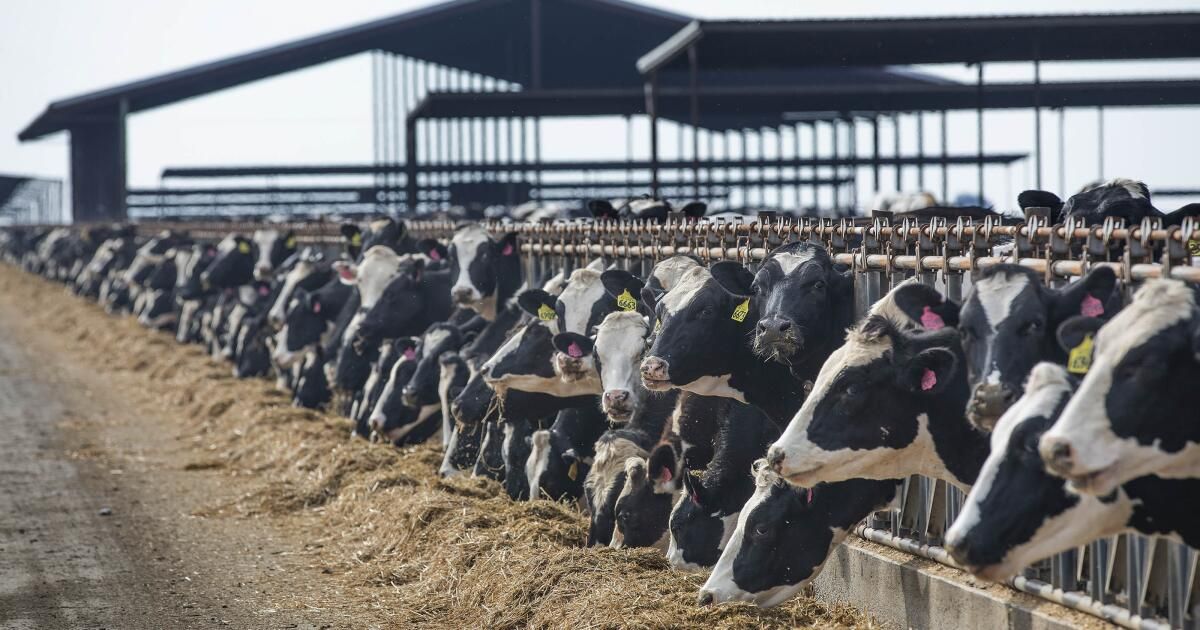Government scientists are warning consumers to stay away from raw milk, citing research showing a “high viral load” of avian influenza in samples collected from infected cows, as well as a worrying cluster of dead cats that had consumed milk. contaminated crude oil.
“We continue to strongly discourage the consumption of raw milk,” said Donald Prater, acting director of the Center for Food Safety and Applied Nutrition at the Food and Drug Administration.
But raw milk enthusiasts are doubling down on the supposed benefits and safety of their favorite elixir, saying the government's warnings are nothing more than “scaremongering.”
Mark McAfee, founder of Fresno's Raw Farm and the Raw Milk Institute, said his phone has been ringing off the hook with “customers asking for H5N1 milk because they want immunity from it.” (No bird flu has been detected in California dairy herds.)
Other raw milk drinkers, like Peg Coleman, a medical microbiologist who runs Coleman Scientific Consulting, a food safety consulting firm based in Groton, New York, said the government's warnings have no basis in reality.
Coleman, an advisor to the Raw Milk Institute, has provided expert testimony on the benefits of unpasteurized dairy in courts across the country.
“It's a fear factor. It is a factor of opinion. It is based on evidence from the 19th century. It’s absolutely ridiculous,” he said, citing research showing that healthy gut biomes and breast milk provide benefits to the immune system.
The process of heating milk to a specific temperature for a specific period of time and then allowing it to cool rapidly is named after French chemist and germ theory pioneer Louis Pasteur. Recently, the FDA reaffirmed the effectiveness of pasteurization in destroying highly pathogenic avian influenza (HPAI) and other viruses, as well as harmful pathogenic bacteria and other microorganisms.
Coleman, however, says the risk of disease is exaggerated.
“All of this is people's opinions, their instincts, their ignorance,” he said. “I think if you did a study and tested the microbiota of raw milk drinkers, it's very possible that you would find a healthier gut microbiota better able to withstand occasional challenges.”
It's a message that health officials and food safety experts consider dangerous and reckless, especially at a time when government investigators are struggling to understand the extent of outbreaks in dairy herds and the potential for harm.
“Deliberately consuming raw milk in the hopes of becoming immune to avian influenza is playing Russian roulette with your health,” said Michael Payne, a researcher and outreach coordinator at the Western Institute for Food Safety at UC Davis. “Deliberately attempting to become infected with a known pathogen goes against all medical knowledge and common sense.”
He and other food safety experts say the safest way to consume dairy is to eat only pasteurized dairy products.
“It's been the gold standard for more than a century,” he said.
The highly pathogenic avian influenza virus has been found in 36 herds in nine states and has been detected in samples of commercially sold pasteurized milk. Tests have shown that these viral fragments are inactive: neutralized by the pasteurization process.
The live virus, on the other hand, has been detected in raw cow's milk and colostrum (the nutrient-rich milk extracted by mammals in the first days after birth) and in a study that examined dead cats on dairy farms. infected with bird flu in Texas and Kansas suggest that contaminated raw milk could be dangerous to other mammals, including humans.
However, the researchers could not definitively prove that the cats acquired the virus through raw milk; It is possible that they consumed sick birds.
It's a point Coleman has seized on, highlighting as evidence that the government's caution about raw milk consumption is misleading.
“Show me it infected cats through the gastrointestinal tract,” he said. “Otherwise, you're just… crying like a wolf trying to blame raw milk or saying… that raw milk is inherently dangerous, even when scientific evidence doesn't support that view.”
He noted that the cats' symptoms were not gastrointestinal in nature. Instead, they developed depressed mental states, their bodies showed rigid movements, they lost coordination, produced discharge from their eyes and nose, and suffered blindness. More than half of the farm cats died. He said that even if the cats had contracted the virus through milk, it was probably as a result of inhaling the milk droplets rather than consuming it.
“Have you ever seen a cat eat?” Coleman asked. “It's messy. If they got the disease through milk, it's probably because they inhaled it.”
Eric Burrough, a professor and veterinary diagnostic pathologist at Iowa State University who led the cat study, acknowledged that there were things they couldn't control and others that “we don't know”; the analysis was “diagnostic.”
But he and his team were able to show that the cats were feeding on raw milk contaminated with high concentrations of the virus and that the pattern of infection and death “does not align with random exposure to wild birds,” he said.
As for Coleman and McAfee's belief that stomach acid and a healthy gut biome would offer protection, he noted that previous studies showing that cats that ate wild birds contracted the virus, suggesting those safeguards are not enough to protect mammals against avian flu.
He said, “There is also the possibility that the virus could enter through the tonsils into the pharynx of cats prior to ingestion in both the poultry consumption and milk consumption scenarios.”
In any case, Payne said, there is enough concern right now that it should give people pause in consuming dairy products that have not been pasteurized.
Even Coleman acknowledged that young children, who are known to be disordered eaters, might consume milk differently than adults. And if his disordered eating theory holds weight among cats, “it's something to think about” with children.
So far, the virus does not appear to have developed any genetic adaptations that would make it more susceptible to being transmitted between people.
So far only one person, a Texas dairy worker infected in March, has been reported to have contracted the disease from cattle. His symptoms were mild: just a moderate case of conjunctivitis or conjunctivitis, according to a case report published in the New England Journal of Medicine.
Local and state health departments have tested another 25 people for the virus and monitored more than 100 for symptoms.
This particular bird flu virus originated in China in 1996, but the clade (or subvariant, known as 2.3.4.4b) found in US dairy cattle became dominant in 2020. Since then, It has killed hundreds of millions of domestic and wild birds, and has been detected on every continent except Australia. It has also jumped to mammals, and is responsible for killing at least 48 different species, including elephant seals, dolphins and sea lions.
Researchers now believe that this clade of the H5N1 virus was introduced by birds to cattle at a site in the Texas Panhandle, and then spread by cattle-to-cattle transmission when cows were moved between different farms. Evidence also shows that infections have spread from cattle to domestic poultry. And samples have been discovered in wastewater.
There have been 887 confirmed cases of human H5N1 infection in 23 countries since 2003. Of those, 462 were fatal. It is unclear whether there were more mild cases that went undetected, something that could potentially reduce the 52% mortality rate.
However, epidemiologists say HPAI is dangerous and potentially fatal. Considering the global spread of diseases between species, they urge people to be cautious and avoid raw milk.
Newsletter
Towards a more sustainable California
Get Boiling Point, our newsletter exploring climate change, energy and the environment, and be part of the conversation and the solution.
You may occasionally receive promotional content from the Los Angeles Times.












